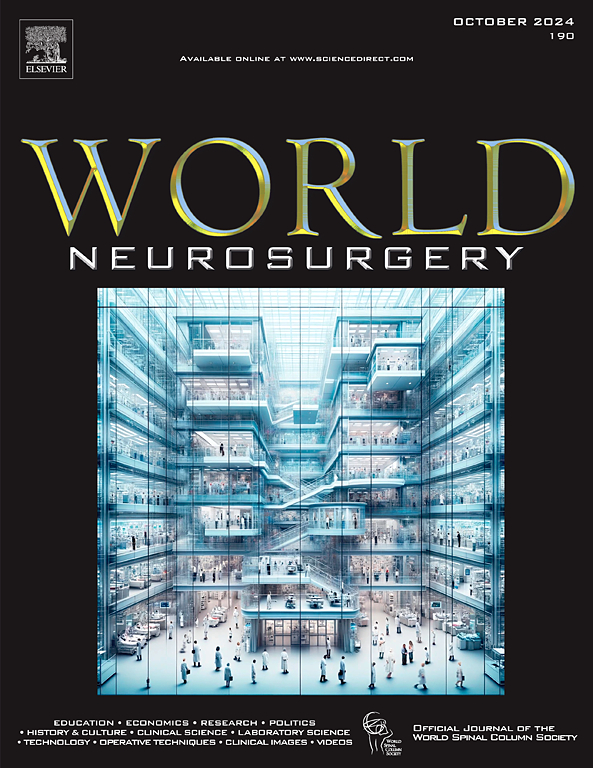胸腰椎手术的引流与非引流:荟萃分析。
IF 1.9
4区 医学
Q3 CLINICAL NEUROLOGY
引用次数: 0
摘要
目的:后胸腰椎手术中放置引流管是常见的,但由于并发症风险的证据相互矛盾,因此存在争议。本研究比较了使用引流与不使用引流的安全性和有效性。方法:对PubMed、EMBASE和Cochrane数据库进行系统回顾,确定使用“引流”、“脊柱”和“随机对照试验”等术语进行随机对照试验。两位审评者独立筛选研究,评估偏倚,并提取结果数据,包括手术部位感染(SSI)、术后硬膜外血肿(PEH)、再手术、输血、换药、Oswestry残疾指数(ODI)和视觉模拟评分(VAS)。进行亚组分析和建议、评估、发展和评价分级(GRADE)评价。结果:共有11项rct符合纳入标准。在单节段手术中,使用引流与PEH发生率显著降低(OR 0.11, 95% CI 0.03-0.40)、术后发热减少(OR 0.62, 95% CI 0.39-0.97)和换药次数减少(OR 0.33, 95% CI 0.13-0.79)相关。然而,在多节段手术中,引流与较高的输血风险相关(OR 2.88, 95% CI 1.13-7.32)。两组间SSI (OR 0.95, 95% CI 0.42-2.16)、再手术(OR 0.88, 95% CI 0.28-2.83)、住院时间、ODI或VAS均无显著差异。结论:后胸腰椎手术中引流管的使用与SSI、再手术率、住院时间或临床疗效无显著相关性。然而,它们的使用与术后输血频率增加有关。在单节段手术中,放置引流管与较低的PEH发生率、较低的术后发热概率和较少的换药次数相关。本文章由计算机程序翻译,如有差异,请以英文原文为准。
Drainage versus Nondrainage for Thoracolumbar Spine Surgery: An Evidence Synthesis
Objective
Drainage tube placement during posterior thoracolumbar spine surgery is common, yet debated due to conflicting evidence on complication risks. This study compares the safety and efficacy of drainage use versus nonuse.
Methods
A systematic review of PubMed, EMBASE, and Cochrane databases identified randomized controlled trials using terms like “Drainage,” “Spine,” and “randomized controlled trial.” Two reviewers independently screened studies, assessed bias, and extracted data on outcomes including surgical site infection (SSI), postoperative epidural hematomas (PEHs), reoperation, transfusions, dressing changes, Oswestry Disability Index, and visual analog scale. Subgroup analyses and Grading of Recommendations, Assessment, Development, and Evaluation evaluation were performed.
Results
A total of 11 randomized control trials met the inclusion criteria. Drainage use correlated with significantly lower PEH incidence (odds ratio [OR] 0.11, 95% confidence interval [CI] 0.03–0.40), reduced postoperative fever (OR 0.62, 95% CI 0.39–0.97), and fewer dressing changes (OR 0.33, 95% CI 0.13–0.79) in single-segment surgeries. However, in multisegment procedures, drainage was associated with higher transfusion risk (OR 2.88, 95% CI 1.13–7.32). No significant differences were observed in SSI (OR 0.95, 95% CI 0.42–2.16), reoperation (OR 0.88, 95% CI 0.28–2.83), hospital stay, Oswestry Disability Index, or visual analog scale between groups.
Conclusions
The utilization of drainage tubes in posterior thoracolumbar spine surgery does not show significant associations with SSI, reoperation rates, length of hospital stay, or clinical effectiveness. However, their use is associated with an increased frequency of postoperative blood transfusions. In single-segment operations, drainage tube placement demonstrates correlations with a lower occurrence of PEH, reduced probability of postoperative fever, and fewer dressing changes.
求助全文
通过发布文献求助,成功后即可免费获取论文全文。
去求助
来源期刊

World neurosurgery
CLINICAL NEUROLOGY-SURGERY
CiteScore
3.90
自引率
15.00%
发文量
1765
审稿时长
47 days
期刊介绍:
World Neurosurgery has an open access mirror journal World Neurosurgery: X, sharing the same aims and scope, editorial team, submission system and rigorous peer review.
The journal''s mission is to:
-To provide a first-class international forum and a 2-way conduit for dialogue that is relevant to neurosurgeons and providers who care for neurosurgery patients. The categories of the exchanged information include clinical and basic science, as well as global information that provide social, political, educational, economic, cultural or societal insights and knowledge that are of significance and relevance to worldwide neurosurgery patient care.
-To act as a primary intellectual catalyst for the stimulation of creativity, the creation of new knowledge, and the enhancement of quality neurosurgical care worldwide.
-To provide a forum for communication that enriches the lives of all neurosurgeons and their colleagues; and, in so doing, enriches the lives of their patients.
Topics to be addressed in World Neurosurgery include: EDUCATION, ECONOMICS, RESEARCH, POLITICS, HISTORY, CULTURE, CLINICAL SCIENCE, LABORATORY SCIENCE, TECHNOLOGY, OPERATIVE TECHNIQUES, CLINICAL IMAGES, VIDEOS
 求助内容:
求助内容: 应助结果提醒方式:
应助结果提醒方式:


